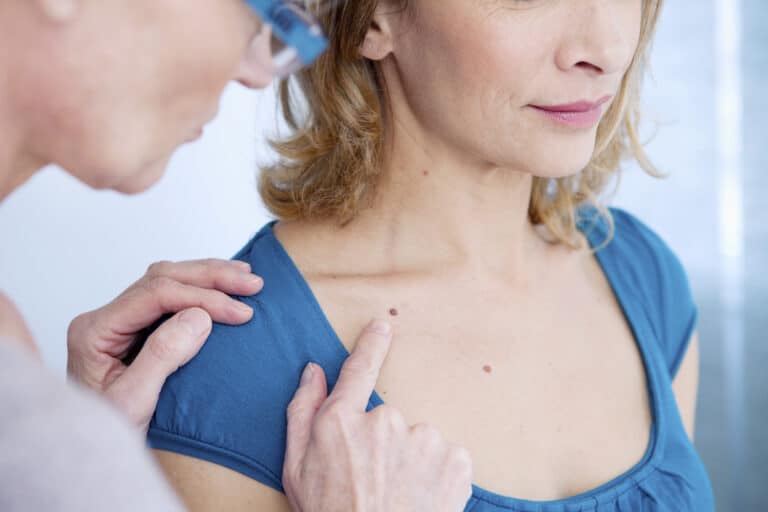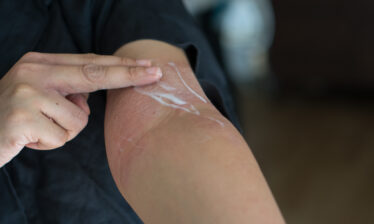Mohs surgery is a technique pioneered by Dr. Frederic E. Mohs in the early 1930s. He studied many cancer specimens under a microscope. He then came up with a method to slowly remove cancer lesions as thin discs of tissue, which could be microscopically examined.1
Mohs surgery is considered one of the most effective treatments for skin cancer lesions because the surrounding healthy tissues are not damaged during the procedure. This technique also has the highest potential cure rate of up to 99%.2
Read on to learn about Mohs surgery, the recovery timeline, and aftercare tips and tricks.
What is Mohs Surgery?
Mohs surgery, also known as Mohs micrographic surgery, is a technique for treating skin cancer. In this procedure, layers of cancerous skin tissue are slowly shaved off one at a time. Each layer is then studied under a microscope until healthy tissue is identified.3
The main goal of this technique is to remove all cancer tissue without damaging the surrounding healthy tissue. This minimizes disfigurement, hastens the recovery time, and improves the cure rate.4
Mohs surgery can only be performed at medical institutions with inbuilt labs. You will be awake, but doctors will numb the area undergoing the procedure. This surgery usually takes three to four hours because of the waiting times when the excised tissue is being examined. While waiting, you can still use the restroom, eat light snacks, and drink water if the surgery site is not close to your mouth.5
Who can use Mohs Surgery?
Mohs surgery is considered the most effective treatment for basal cell carcinoma and squamous cell carcinoma, the two most common types of skin cancer. It can also treat melanomas and other less common skin cancer lesions.6
Mohs surgery is suitable for you if:7
- Your cancer lesion is quite large and rapidly growing.
- It has uneven margins.
- Your lesion is located at a sensitive place like your face, where you’d like to preserve as much healthy tissue as possible.
- Your cancer lesion has a high chance of growing back or has previously grown back after another treatment.
One of the greatest benefits of Mohs surgery is that you’ll know the outcome immediately. Although your procedure will end after the entire lesion is removed and skin reconstruction is completed, you’ll still require follow-up visits.
How Long Does Recovery Take After Surgery?
Your follow-up care and Mohs procedure recovery time mainly depend on the location and extent of the tissue that was removed. If the tumor removed was very large, in a sensitive location, or skin grafting was required for reconstruction, you may have a longer recovery time.8
You’re likely to be exhausted after the surgery, so plan to take a rest and avoid any strenuous activities like jumping, stretching, or bending for the next few days.9
Your doctor will bandage the surgery site. You should probably keep this bandage on for at least 24 to 48 hours after the procedure. Strictly follow your doctor’s instructions for wound care and pain management. You may be able to resume your work routine after a couple of days.10
Swelling is expected to resolve in 3 or more days. Bruising may take 2 to 3 weeks to resolve.11 In most cases, the stitches are removed within a week of the procedure if the wound is healing well and there’s no bleeding, infection, or other complications.12
Your next follow-up visit is expected to be a month after the procedure. Your doctor will check on the healing progress of your wound. You will be referred to your attending physician if there are no issues. After that, you’ll need follow-up visits at 6-month intervals with your dermatologist. This is to make sure that your cancer hasn’t come back.13
Your wound may take up to a year to heal completely, and you may be left with a scar that would need a few more months to lighten.14
If you experience pain, swelling, or discoloration or notice any new growth, consult your physician immediately and don’t wait for a follow-up visit.15
What to do After Mohs Surgery?
The post-procedure care for Mohs surgery involves several aspects:16
- Dealing with cancer can be stressful, even if this is not your first procedure. Although this procedure has a high cure rate, you may still feel anxious during the healing period. You may be worried about a scar or other side effects of the procedure. Don’t bottle your feelings, and share all your concerns with your doctor.
- Although this is a minimally invasive procedure, you’re likely to experience some pain, swelling, bruising, and discomfort after the surgery. Your doctor will recommend painkillers like acetaminophen or ibuprofen.
- If you notice any bleeding, apply pressure at the site for 10 minutes. If the bleeding hasn’t stopped after another 10 minutes, seek medical care immediately.
- To reduce pain and swelling, don’t bend too much below the level of the heart.
- Sleep with your head raised by two pillows if your surgery was performed on your face.
- Keep your arms and legs elevated to accelerate healing if your surgery was on your limbs.
- Don’t apply ice directly to your wound, and don’t keep it on for longer than 15 minutes at a stretch.
- Keep your bandages clean and dry. Shower with the dressing off, then blot the wound dry and rebandage. Avoid swimming pools, saunas, and hot tubs.
- Always wash your hands carefully before handling your wound or dressings.
- Clean the wound regularly until the stitches are removed, and the skin is healed.
- Use water to gently remove the old bandage. Depending on the size and nature of the wound, use gauze and tape, an adhesive bandage, or special dressings like Gelfoam or Surgigel.
Other Considerations
If you’re planning to undergo Moh’s surgery, here are some things to remember.17
- Discuss your allergies and other health concerns with your surgeon.
- Avoid smoking and alcoholic beverages before the procedure.
- Get a good night’s sleep, so you’re not stressed during the surgery.
- Wear loose and comfortable clothing for the surgery.
- Carry items to entertain yourself during the long wait times.
- Ask someone to accompany you to the procedure.
To learn more about Mohs surgery recovery and other skincare treatments, explore My Skin Treatment today.
SOURCES:
- American College of Mohs Surgery: “History of Mohs Surgery”
- American College of Mohs Surgery: “About ACMS.”
- Healthline: “What You Need to Know About Mohs Surgery.”
- Healthline: “What You Need to Know About Mohs Surgery.”
- Healthline: “What You Need to Know About Mohs Surgery.”
- Cleveland Clinic: “Mohs Surgery.”
- Cleveland Clinic: “Mohs Surgery.”
- VeryWellHealth: “Mohs Surgery: Recovery.”
- Healthline: “What You Need to Know About Mohs Surgery.”
- Healthline: “What You Need to Know About Mohs Surgery.”
- VeryWellHealth: “Mohs Surgery: Recovery.”
- University of Rochester Medical Center: “Mohs Surgery Post-operative Care.”
- University of Rochester Medical Center: “Mohs Surgery Post-operative Care.”
- VeryWellHealth: “Mohs Surgery: Recovery.”
- University of Rochester Medical Center: “Mohs Surgery Post-operative Care.”
- VeryWellHealth: “Mohs Surgery: Recovery.”
- Healthline: “What You Need to Know About Mohs Surgery.”






